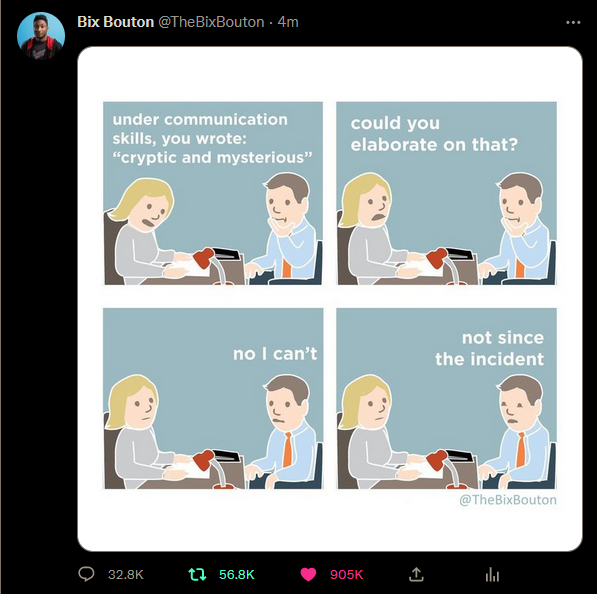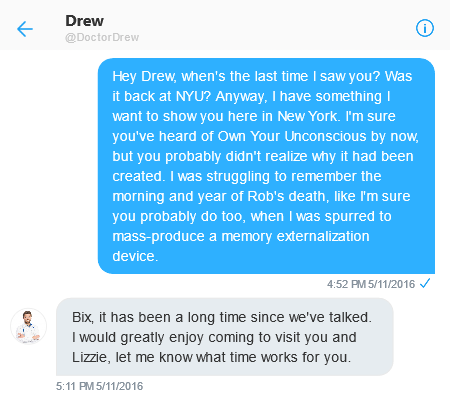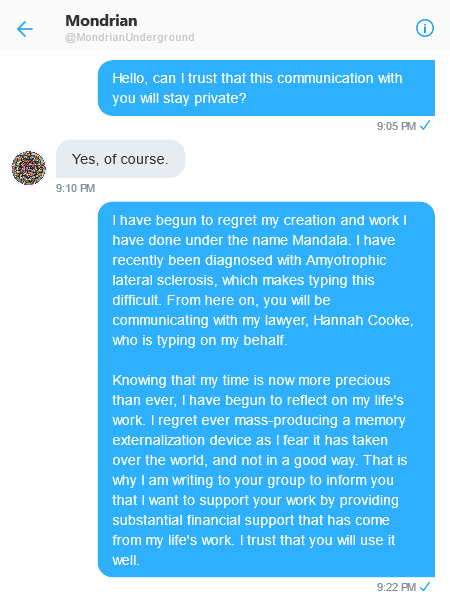Bix Bouton Character Analysis
By Kenyon Geetings
Character Description
Bix Bouton is Jennifer Egan’s main character who isn’t actually the main character in her novel The Candy House. While it would certainly be challenging to create this story without our character Bix, he’s really only a conduit for setting up the story as well as providing us something to circle, or spiral, back to near the end for an attempt at closure. In order to present Bix as the semi-rounded character that Egan developed, we must first learn about some of the basics. Bix is a forty-one year old black man who is most known for being the creator of Mandala and subsequently Own Your Unconscious (Egan 15). This business turned out to be incredibly successful and made him into a “tech demigod” (58) known around the world.
The world of business was not the only thing that contributed to Bix’s personality. He was married to his wife Lizzie, and had four children. The oldest of which was Richard, the youngest was Gregory, and he also had two daughters (278). He struggled with wanting to have deeper, more meaningful conversations with his wife, but the work she did often left her tired and unable to do so.
One night, while searching for this deeper conversation Bix, a habitual flaneur, strolled downtown and ran into a flier for a discussion meeting about Miranda Kline’s Patterns of Affinity. It was at this meeting that he attended, disguised as a graduate student in electrical engineering named Walter Wade (that was loosely based on himself seventeen years ago), that he would come up with his new idea of Own Your Unconscious.
Near the end of the book while we do not learn a lot more about Bix, we do learn that he died from ALS. We also learn from Bix’s lawyer, Hannah Cooke, that most of Bix’s life savings went to Mondrian, a group that went against most of what Bix has developed at Mandala. Hannah was reluctant to give out more information than this, aptly following her nickname “the Vault” (285). One can only assume that Bix had begun to regret his creations later in life.
Platform Justification
The platform that I felt fit Bix’s personality the best was the social media app Twitter. While it is not the most popular social media app, it is still used by millions of people around the world. Twitter is a social media app that allows users to post short messages, or “tweets,” that are limited to 280 characters. These tweets can be seen by anyone who follows the user, and can be retweeted by anyone who sees them. This is what makes Twitter so dangerous, as it allows people to post whatever they want, with the idea that no one will really notice, but if a tweet gains traction then it can quickly spiral out of that person’s control.
The reason that Twitter makes sense for Bix is because of the way that it is structured. It lulls people into a sense of safety that they can post whatever they want on it, without anyone really noticing, which I think perfectly encapsulates what the argument around Mandala really is. With Mandala a lot of people were all too willing to give up their thoughts to the Collective Consciousness in order to “gain proportionate access” to the thoughts of others (54). Most people probably assumed that what they gave away to the collective would not really be seen by others, and that what they would gain from it would outweigh the negatives, just like we see with Twitter. Twitter also makes sense because it is known for people stealing other people’s tweets and pretending they are their own. For example, there might be a popular meme page that posts other people’s tweets but does not give the original author any credit. This is something Bix also does when he attends the Patterns of Affinity meeting where “He listened, he witnessed,” (14) but where he takes the ideas that he hears and turns them into his own. And even before, where he steals the concepts from Miranda Kline and turns them into Mandala.
Bix is a very “private man,” (286) but he also likes to be the center of attention. He likes to be seen as a genius, and he likes to be seen as a person who is always coming up with new ideas. Twitter allows him to do both of these things. The fact that he was unable to come up with a new idea ate at him and “destabilized his sense of everything he’d done” as he often worried that what he had come up with was not enough and that it was not worth it “if it led to nothing” (16). Twitter gives people this ability to become faux geniuses while at the same time allowing them to become the center of attention even without having a large platform of their own.
Audience and Goals
Bix’s audience is a little difficult to pin down because of its seemingly kaleidoscopic change over time, but I think that initially he wants to reach and connect with his friends, mainly Drew. Drew was a good friend of Bix’s from college who later helps save people's lives and becomes a doctor. Both Drew and Bix want to understand how their friend Rob drowned, and “why would anyone swim” (24) in the river. It all happened quickly on the morning of April 6, 1993 where Drew had just gotten into a fight with Rob and they both made their way into the Easy River, only for Rob to be carried away with the current and drowned (56). Both Drew and Bix blamed themselves for this accident and each wished they could find a way to change it.
I think that Bix's audience proceeds to shift to a group of people that allows him to grow and build ideas off of, or in some cases just outright steal them. While it is probably not necessarily considered an audience since Bix is doing more of the listening rather than the talking, I still think both sides have something to gain from this relationship. In this stage of Bix’s life, I see him as being more of a “lurker” where most of the time he sits back and watches, but when he feels it necessary he comes out of his “shell” to share his ideas.
Finally, I think Bix wants to get in contact with Mondrian, and Miranda Kline in an attempt to salvage what he can from the mess that he made with Mandala, as I think he regrets most of it, and wants some sense of closure. I believe that he wanted to reach out to Miranda Kline for more than just thanking her for the inspiration that her book gave him, but also to express sympathy for him buying her intellectual property that “someone sold” but that was “not Kline” (17), which had effectively meant that she did not get any of the appreciation that she deserved. Mondrian, the company known for going against most of Mandala’s creations, being the final audience of Bix shows that he felt some remorse for what he had developed.
Language Analysis
The language that Bix uses reminds me of a nerdy tech guy who just happened to find his way into the world of business. He is very analytical, although most of this analysis seems to take place in his head rather than out loud. For the most part he really likes to keep to himself. We can also see that he enjoys deep conversations, but that he was often unable to find people who could talk "in that casual, wide-open, studenty way that people talked in college" (8).
This also leads to my next point about how Bix often seemed to be stuck in the past. In fact, it was his reflection on his friend's death that led to the creation of Own Your Unconscious, and it was also his reflection on the past that inspired his alternate character, Walter Wade. When Bix is in this alternate character we see him asking a lot of questions about the history of people such as Miranda Kline, Rebecca, and Ted. Even when he is not asking a lot of questions, Bix seems to have lots of flashbacks to his childhood and how things used to be.
While Bix is not playing his fake identity, he is also known for not using profanity. And with his mother being a "sixth-grade grammar teacher" (13), one could also assume that his word choice is very deliberate. This works well with the concept of disguise as a lurker where Bix purposefully chooses when to speak, and when he speaks he makes sure his words carry significance.
Profile Break Down
Link to Bix Bouton’s Twitter Account: https://twitter.com/TheBixBouton
Profile Picture:
I chose this picture for a variety of reasons, one of which is because of how generic it is. This headshot profile picture is just one of thousands that you might see on Twitter throughout your feed, there is nothing that makes it stand out. I think Bix would look about the same, and with just a simple switch of the hoodie, and possibly a “headscarf with dreadlocks” (12), he could probably pass for someone like Walter Wade. One of the other reasons I like this picture is because of how much this photo looks like someone in tech might look. I’m not sure if I can fully explain why I feel this way, but the mixture of a hoodie, a well kept and clean person, who is only sort-of smiling, and a generic blue background fits this look well.
Profile Background Image:
I chose this background image as it broadly explains what Mandala as a company is trying to accomplish. Its goal is to connect everyone around the world with the “Collective Consciousness” (54). This image also has a “tech” feel to it with the way the earth is made of several pixels and the weird “solar flare” reminds me of video game worlds that all seem to have fake camera flares when looking at the sun. In addition to that, the entire image is animated, further giving off the feeling of technology and how it connects and portrays us throughout the world.
Profile Joined Date:
As you can see by the picture to the left, I think Bix would have been an early adopter of new social media and technology. In the case of Twitter, it was created in July of 2006, and therefore I think Bix would have been one of the very first people to trek this new uncharted world of 140 character length tweets. In Bix’s persistent pursuit to create the newest technology, he first has to understand how other technology works in order to build off of it. And as we see when he links his computer to “the Viola World Wide Web” he enjoys being on the brink of new tech, where anything mainstream today will “soon be obsolete” (8).
Profile Following and Followers:
I think Bix’s follower count is probably one of the more obvious things about his profile as he was “a tech demigod on a first-name basis with the world” (58). While he may not have wanted all of the fame in the end, he certainly made a deliberate choice to continue to create new products for Mandala as a way to stay relevant. What is more interesting is Bix’s following count. I believe he liked to keep his friend group extremely small, and his following count would be the same. The reason that it is still more than ten is that I think he also would have enjoyed following intellectual accounts and other tech demigods where he could converse and gain ideas from.
Profile Bio:
One thing that might seem to be missing from the photo on the left is Bix’s bio, but rest assured that it is not there on purpose. The purpose of a Twitter bio is often used as a way to explain a little about what you do and sometimes as a sort of credential that proves that what you have to say is worth following for. In the case of Bix, I think the reason that he would not have a profile bio would be twofold. One reason is that he is already known to the world on a first-name basis as mentioned before (58). And the other reason is because of Bix’s old habits of being a lurker, as even when he becomes famous, I still believe that he would rather go unnoticed most of the time.
Stolen Tweets:
A common characteristic of certain parts of Twitter involves small, low follower accounts tweeting something funny or smart, only for a large account to steal their tweet and pretend it is their own, where normally the big account will get several more tweet “impressions” than the small account. I believe this is roughly what Bix did to Miranda Kline, and subsequently to the discussion meetings about her, where he got several of his ideas for Mandala. As this tweet shows, I think Bix would have been one of those big accounts that stole jokes and tweets from other smaller users, in this case he has taken a comic from @nathanwpyle and watermarked it as his own work.
Private Message with Drew:
One of the more unseen parts of Twitter is its use as a direct messaging service. This is where I think Bix would have spent a lot of his time on Twitter because as mentioned above, he was a very private man (286). I believe one of the messages that had to be sent was his message to Drew, one of his best friends from college. I imagine this conversation between Drew and Bix to be quite short because each of them are too afraid to ask the other what they truly think about Rob’s death. Which is shown even when Drew is watching Bix’s memory as Bix has “silenced the thought-and-feeling” (58) part of his consciousness.
Private Message with Mondrian:
Finally we also have a private conversation with the group called “Mondrian,” the group that is actively going against what Mandala wants. I think Twitter would have been an obvious place to get in touch with Mondrian, as Twitter moves to end-to-end encryption DMs that would have made this communication secure and safe. While it might not be the only place for him to get in contact with Mondrian, Twitter is also a great social media site to get in quick contact with large organizations that might normally take jumping through a lot of hoops to call or meet with.








